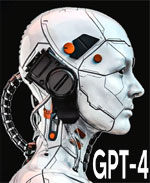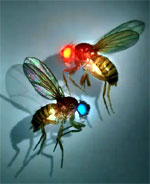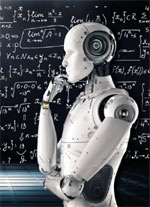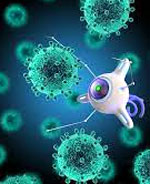

Life-Changing Technologies
Technological Breakthroughs
These ground-breaking technological wonders redefine life as we live it. May 18, 2024
May 18, 2024
Taking a Free Online A.I. Course
AI Course Name: Elements of AI
Offered by: University of Helsinki and MinnaLearn
Course Features: Free Online, Certificate Available, 6 weeks, 5-10 hours a week, On-Demand
About: Artificial Intelligence, Machine Learning, Neural Networks, Critical Thinking
Course Objective: to demystify AI
Offering Date: May 14, 2018 (I'm taking this course in 2024, 6 years later. Question: Is this obsolete?)
Glossary
- Machine learning - systems that improve their performance on their own in a given task with more and more experience or data (AI adaptability). Machine learning is a type of artificial intelligence that allows computers to learn from data and improve their performance over time without being explicitly programmed. Imagine teaching a computer by showing it lots of examples. For instance, to recognize cats in photos, you feed it many cat images. The computer then finds patterns and learns what a cat looks like. Over time, it gets better at identifying cats on its own. Machine learning is used in many areas like email spam filtering, recommendations on streaming services, and voice recognition on smartphones. It's like giving computers the ability to learn and make decisions.
Machine learning is learning from experience. - Deep learning - Deep learning is a type of artificial intelligence that teaches computers to learn from lots of data, like how our brains work. It uses layers of "neurons" in a network to recognize patterns. There are different kinds, like those for understanding pictures (CNNs), sequences (RNNs), and language (transformers). This technology helps with tasks like identifying objects in photos, translating languages, and understanding speech. However, it needs a lot of data and powerful computers to work well. Despite these challenges, deep learning is making significant advances in fields like image recognition, natural language processing, and robotics.
Deep learning is learning from data...lots and lots of data. - Robotics - Robotics is the field of creating machines, called robots, that can perform tasks on their own or with minimal human help. These robots can be designed to do a wide range of activities, from assembling cars in factories to vacuuming floors at home. They use sensors to understand their environment and computer programs to decide what actions to take. Some advanced robots can even learn from their experiences. The goal of robotics is to make machines that can help humans by doing jobs that are repetitive, dangerous, or require precision. Robotics is the ultimate challenge of AI since it involves so many aspects of AI - computer vision, speech recognition, language processing, facial expression, etc. According to Elon Musk, AGI is won in the real physical world because robots need to interact physically with the real world, thus Tesla (having an AI to be fully self driving) and Optimus (the robot), are ahead of the AGI game.
- Robot - in AI, a robot is a vehicle/machine that has sensors (to map the environment) and actuators (to act on the environment, depending on what it needs to do) with little or full autonomy. ChatBots are not technically robots.
- Data science - Data science is the process of making sense of complex data to find answers and make decisions. It combines math, statistics, and computer skills to analyze large amounts of information. Data scientists collect data from various sources, clean it to remove any errors, and then use tools and techniques to uncover patterns and insights. For example, they might analyze shopping data to understand customer preferences or study medical records to find new health trends. The goal of data science is to make sense of complex data and use it to solve problems, predict outcomes, and help businesses and organizations make better decisions.
Data science makes sense from lots of data to solve problems. - Statistics - the science of collecting, analyzing, and interpreting data to find patterns and trends. Statistics play a major role in AI. It helps us make sense of numbers and data by using tools like averages, graphs, and probability. For example, statistics can show the average score of a class on a test or predict the chance of rain tomorrow. It is widely used in various fields like AI, medicine, business, and sports to make informed decisions and predictions. By understanding statistics, we can make better sense of the world around us and make more accurate conclusions based on data. Statistics is fundamental to the development of AI algorithms
- Data science vs Statistics - In AI, Data Science uses statistical methods as part of a wider range of activities including data handling, machine learning, and domain-specific applications. Statistics provides the foundational methods for data gathering, analysis, interpretation and presentation to apply AI solutions.
- General vs Narrow AI - Narrow AI is designed to do and be very good at doing one task - like play chess. It cannot draw, it cannot converse or do anything outside chess. General AI or AGI is an Ai system doing everything intelligently like a human would. This is still in the realm of science fiction. Despite almost 50 years in aiming for this, nothing tangible has come out of it. Narrow AI on the other hand has grown leaps and bounds.
- Strong vs Weak AI - Strong AI is one that has a mind and sentient (like a human mind, but we are not theree yet with AI). Narrow AI is acting intelligently but not intelligent (like a self-driving car)
- Nodes - all possible positions in a State Space.
e.g. all possible moves in a chess game - Heuristic - a 'rule of thumb', this is a technique that guides an AI program towards a solution but not necessarily guaranteeing a win. Instead of an exhaustive search for all possible moves which can take too long and consume too much resources, heuristics will give a 'good enough' answer - efficiency. Heuristics learn from experience, so it gets better with time and practice. It breaks down complex problems into smaller, more manageable sub-problems. Because it is not guaranteeing a win, there is no 'long term' consideration - only short term gains.
- Game tree - a tree-like representation of all possible moves by the opponent. In the game tree, the nodes are arranged in levels that correspond to each player's turns in the game so that the "root" node of the tree (usually depicted at the top of the diagram) is the beginning position in the game
- Minimax algorithm - in AI game theory, this is a decision-making algorithm with a 'suggested move' to minimize the loss, assuming the other player is making all the right moves. This entails 4 elements in play - zero-sum, deterministic, full knowledge and 2 players. This algorithm uses a game tree where nodes represent all possible game states (all possible positions in the game), edges represent possible moves, and leaf nodes represent terminal game states where the final end result is arrived at (win, lose or draw).
This algorithm is optimized by heuristics (limiting the scope only to a certain depth and gives its best suggestion) and Alpha-beta pruning (it eliminates parts of the game tree that does not influence the outcome of the game, thus minimizing resources).
Minimax is applied in games like chess and tic-tac-toe. It is also applied in decision-making particularly in complex problems. - Base-Rate Fallacy - this is when people disregard the Prior Odds (base rate) and only look at the new information in making decisions. This is like making a decision based on a snapshot instead of seeing a trajectory or pattern from past events. This mistake happens because factoring-in the base rate requires more cognitive effort and statistical understanding which is daunting. Thus wrong conclusions are made. By using the Bayes Rule, this mis-step is avoided.
- -
- -
- -
- -
- -
Need to Level-up
I was having lunch with Kat when she deliberated on the many ways AI is more relevant and more compelling - including having AI be the 'teacher' for home-schooled kids. I was blown away. I thought I was already proficient with AI, but now I realized I had to level-up my game. Where to start? From the bottom - what is AI?

Online Free Courses
Luckily, there are many free AI courses offered online. This is how I learn - SIY (Study It Yourself). There are even sites evaluating which free online courses are best and some of these free online courses also also certification! How cool is that?
One such institution is the University of Helsinki offering the course, Elements of AI. You're on your own, but it limits you to
6 weeks, 5-10 hours a week at most. Certification is also available. It's a basic course that essentially demystifies AI. It gives you a solid foundation on AI from where you can take it to higher learning. There is no complicated Math and no programming is required.
Course: Introduction to AI
Chapter 1: What is AI?
[an error occurred while processing this directive] [an error occurred while processing this directive]1c. Philosophy of AI
AI is not pure science. There must be a mind in AI. Can the AI mind become sentient? There are a lot of philosophical conundrums to deal with. Is human consciousness computational?
The Turing test
If an individual cannot discern if he is dealing with a fellow human or a computer, then the computer passes the Turing Test, meaning the computer already thinks and engages at the level of a human.
One problem: does being human-like mean you are intelligent?
Eugene, a child chatbot answered unintelligible answers in the same way a short attentionspan kid would, but it fooled many judges and passed the Turing Test. So, maybe the Turing Test was not about intelligence but human behavior?
The Chinese room argument
Even though the guy outside received intelligent answers and thought he was dealing with a human being on the other side of the room, the other human being was only getting instructions from a book without really knowing what is being said. So, the 'Turing' computer may give all the right answers and fool the other guy, but there is no real intelligence at play - just broken down small mechanical instructions that can be automated.
Is a self-driving car intelligent?
When a car drives by itself, it appears intelligent because it is behaving intelligently. But intelligent behavior is not necessarily being intelligent the way a human is. AI systems do not understand its environment the way a human knows it's embroiled in traffic at rush hour. Being intelligent (human) is different from acting intelligently (self-sdriving car).
How much does philosophy matter in practice?
Philosophical discourse with friends over a few drinks is intellectually stimulating, but hardly makes a dent on the way AI systems are developed and manufactured. Philosophy and practice do not necessarily impact the other. Thus the focus of this course is the 'practical practice' part and not on philosophy.
Chapter 2: AI problem solving
 2a. Search and Problem Solving
2a. Search and Problem Solving
Search
Most problems are actually Search problems even if it's not too obvious at the outset. After identifying the problem, best way is to start with choices available and then the goal (at what point is the problem solved?). From those 2 end points, we work on the sequence that would take us from the problem to the end goal.
Toy problem: chicken crossing
It's a simple problem and it's easy to see the solution without setting up the 64 possible scenarios. But for complex problems with combinations running into millions, it's best to use the computational approach since human thinking will fail at that load.
State Space
This is the state of all possible situations to get from point A to the end goal. In the chicken-crossing puzzle, the state space consisted of ten allowed states NNNN through to FFFF (but not for example NFFF, which the puzzle rules don’t allow). If the task is to navigate from place A to place B, the state space could be the set of locations defined by their (x,y) coordinates that can be reached from the starting point A. Or we could use a constrained set of locations, for example, different street addresses so that the number of possible states is limited.
Transitions
This is the movement from one state to another. A series of movements constitute a Path.
Costs
This is the cost (not necessarily money) for the transition. Some transitions are cheaper than others. If the goal is to take the shortest distance, then kilometers would be the natural cost. If the goal is about getting there the fastest time, then time is the natural cost.
Exercise 6: The Towers of Hanoi
Below are all the possible states:

 2b. Solving Problems with AI
2b. Solving Problems with AI
Modern computer
Alan Turing maintained that anything computational can be automated. This led to the invention of the modern computer. During its time, it was ground-breaking and led in large measure to the defeat of Germany during WWII.
Intelligence is computational
John McCarthy, known as the Father of Modern AI, coined the term "artificial intelligence". He maintained that any aspect of learning can be quantized so that a machine can simulate it. In short, any element of intelligence can be broken down into simple mechanical steps that it can be written down as a computer program. Intelligence is intelligence, even if it came from a computer program. Intelligence is not necessarily a biological monopoly.
Why search and games became central in AI research
Subsequent development of computers gave rise to AI algoriths that were experimented on. The most popular field was in games - chess, checkers and ultimately, GO. Sophistication in Games, Search and Planning gave rise to advanced algoriths like Minimax Algorithm and Alpha-Beta Pruning.
 2c. Search and Games
2c. Search and Games
Tic-tac-toe Game trees
This is a simple 2-player game and a great example of a classic AI problem. Game tree is very similar to the Search state space diagram except that it starts from all the possible moves the opposing player can make. The game is over if someone makes a straight 3-in-a-row or if the game is a draw.
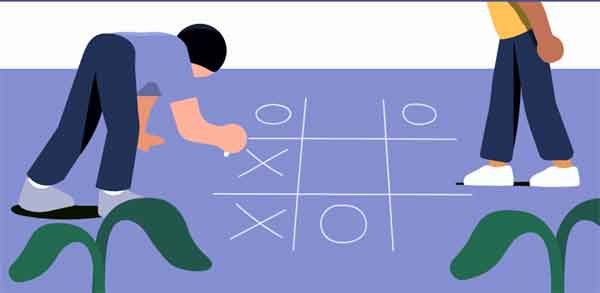
Minimizing and maximizing value
A numerical value is attached to each possible end result, e.g. "+1" when Max wins and "-1" when Min wins. It is "0" when it's a draw. When forced moves for an inevitable win is already evident (just like chess), then AI already knows the outcome long before the final move is taken. So, if Max will inevitably win, then AI gives a "+1" value even if the game hasn't officially played out in its entirety.
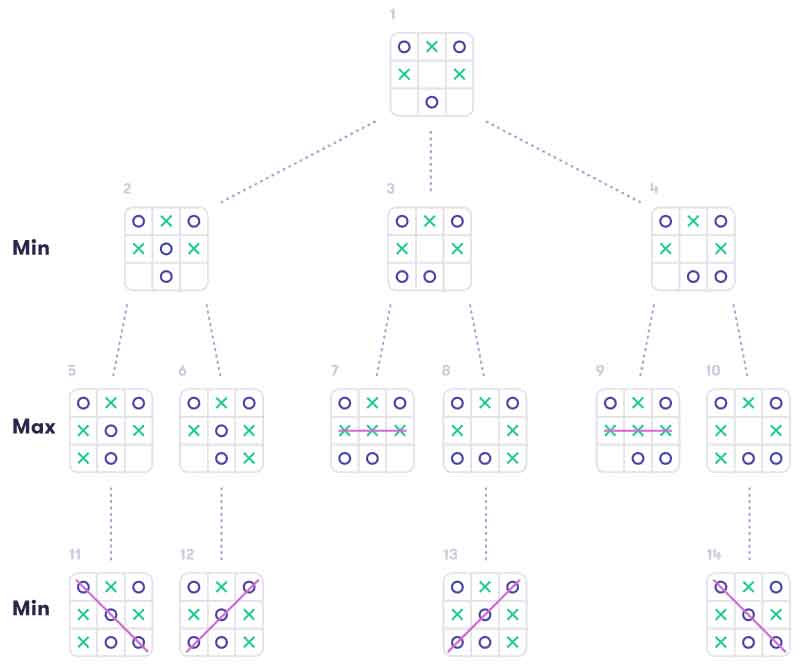
The Minimax algorithm
Minimax is a recursive algorithm that guarantees the optimal moves in a game for a sure win, if the outcome has already been determined in advance based on current positions and forced moves or inevitable win. It's goal is to make the best possible move from all possible moves given the predictable outcome of every move.
The following conditions must be met:
- 2-player game - the variables are limited but the game tree can be huge like chess - for every 2 moves, the 'children' (possible moves) are about 1225! Three moves? Over 42k nodes (possible resulting positions). But even for just 2 people playing GO, the game tree is so vast that Minimax is no longer viable
- deterministic - predictable outcome like moving a chess piece, no randomness like throwing a dice
- zero-sum game - the other's gain is somebody's loss. There is no such thing as everybody wins...someone has to lose
- perfect information - both players have complete knowledge of the game situation like chess...unlike when you throw a dice or draw from a shuffled card
More tricks: Managing massive game trees
For massive Game Trees, there are a few tricks, some of them employed with Deep Blue in defeating Kasparov in 1997. To stop the Minimax before it reaches the end game, the heuristic evaluation function is utilized given the current board game situation.
Good heuristics
Good heuristics assign a value to the weight of the chess pieces, e.g. a Queen has 9X the value of a pawn. It also weighs the remaining pieces on the board and where they are located.
Depth-limit
The number of steps that the Game Tree has been expanded to present a heuristic evaluation function at all nodes.
The limitations of plain search
The 'search' algorithm seems to be perfect and mechanical by simply going down the game tree until the optimized route is established. But that is not so simple in the real world. Even in a simple real-world situation, the game states can be so complex that heuristics and alpha-beta pruning cannot work anymore. Furthermore, the transition states may not be deterministic, out of our control or simply unknowable.
Chapter 3 introduces the added complexity of uncertainty and probability to simulate real world problems.
Chapter 3: Real world AI
 3a. Odds and probability
3a. Odds and probability
On paper, it's easy to have a car go from Point A to Point B while in compliance to all the laws. But in the real world, there is traffic, accidents, bad weather, pedestrians, etc. It's not so simple anymore. A self-driving car also has sensors (for non-visuals like sonar, infra red) and cameras (for visuals). They usually create noise which corrupts the data.
Probability
One of the reasons why modern AI methods actually work in the real world - as opposed to most of the earlier good old-fashioned methods in the 1960-1980s - is the ability to deal with uncertainty. The real world is full of uncertainty, missing information, and even deception.
Back in the day, there were many approaches to handling uncertainty in developing AI systems. The most common then was Fuzzy Logic. But now, it is unanimously accepted and practiced to use Probabilities to handle uncertainties.
Why probability matters
We are familiar with probabilities. What is the probability that tossing a coin will land heads up (50%). But there are other real-life application of probabilities too. What's the probability of rain in this date on the calendar? What's the probability that interest rates will go up in the next quarter? These are all uncertainties that we find an educated guess for answers.
The best way to understand probability is to see it as a quantifiable number, and therefore, comparable to other numbers. Probability provides a systematic way to quantify uncertainties so that it falls within the realm of rational thinking...and not gut-feel speculation.
Why quantifying uncertainty matters
If we think that uncertainty cannot be quantified or measured, then there is no basis for rational decision-making. And in the absence of that, making a decision becomes a hit-or-miss draw of the lot.
Since this is an AI course, automating uncertainty through probabilities is underscored, e.g. fitering spam.
Odds
Uncertainty is best understood by presenting the odds - this can more readily shift public assumptions. Odds are usually expressed as ratios, e.g. 3:1 (the ratio of milk to water is 3 parts milk and 1 part water)
Why we use odds and not percentages
75%, .75 and 3:1 all represent the same thing. But people get confused with percentages and fractions, so it's best to use odds and ratios in AI talk.
Odds (ratio) and Probabilities (% or fraction) are NOT the same
1:5 ratio is not the same as 20%. 1:5 loss means for every 6 games, there is one loss. 20% loss means for every 5 games, there is one loss. Keep this in mind when dealing with probabilities and odds.
Converting Odds to Probabilities
x:y ratio = x/(x + y)
5:1 ratio = 5/(5 + 1) = 5/6 (fraction) = 83% probability
 3b. The Bayes rule
3b. The Bayes rule
Updating with new evidence
The details and complexity of Probability Calculus will not be discussed in this course, but one formula must be taken up - the Bayes Rule or Bayes Formula or Bayesian Inference.
This formula is both simple and elegant. It is also very powerful and can be applied to nearly all of science in weighing conflicting evidence, in a court of law, spam filtering, medical diagnosis, etc. Of course, in AI, Bayes Rule is applied to Machine Learning, Data science and decision-making processes. Bayes rule is to update current probabilities based on new information.
Bayes Rule is expressed in many ways, one of which is Odds. We first take the odds of something happening (vs the odds of it NOT happening), the question being, "Given the new evidence, it the original hypothesis (Prior Odds) still true?".
The equation to compute for the Bayes Rule is:
H = (H), Hypothesis, the odds before new Evidence was obtained
E = (E), Evidence, new information that tests if the Prior (H) still holds true, E = E|H X H + E|*H X *H (*H is the negation of the H)
L = (E|H), Likelihood, odds that the old Hypothesis (H) still holds true given the new Evidence (E)
Posterior = Likelihood Ratio / Prior (H) = (H|E)
Prior odds
The Prior Odds - the odds is the current probability before new information became available. The idea is to update the Prior Odds when new information becomes available.
Posterior odds
New probability when additional information is added to the Prior odds. This is mathematically arrived at by: Posterior Odds = Prior Odds X Likelihood Ratio.
How odds change
New evidence or new information changes the odds. This new information adds a 'Likelihood ratio' which changes the Prior Odds to a new Posterior Odds.
Likelihood ratio
This is a measure given to determine how new information changes the odds of something remaining true. This ratio is essential in updating the Prior Odds to obtain the Posterior Odds. To get this result, the Bayes Rule has to be applied.
Base-Rate Fallacy
This is when people disregard the Prior Odds (base rate) and only look at the new information in making decisions. This is like making a decision based on a snapshot instead of seeing a trajectory or pattern from past events. This mistake happens because factoring-in the base rate requires more cognitive effort and statistical understanding which is daunting. Thus wrong conclusions are made. By using the Bayes Rule, this mis-step is avoided.
 3c. Naive Bayes classification
3c. Naive Bayes classification
One of the most useful applications of the Bayes rule is the so-called Naive Bayes classifier.

Chapter 4: Machine learning
[an error occurred while processing this directive] [an error occurred while processing this directive] [an error occurred while processing this directive]Chapter 5: Neural networks
[an error occurred while processing this directive] [an error occurred while processing this directive] [an error occurred while processing this directive]Chapter 6: Implications
[an error occurred while processing this directive] [an error occurred while processing this directive] [an error occurred while processing this directive]Ending Thoughts
xxxxxxxxxxxxx
--- Gigit (TheLoneRider)
YOGA by Gigit ![]() |
Learn English
|
Learn English ![]() |
Travel like a Nomad
|
Travel like a Nomad ![]() |
Donation Bank
|
Donation Bank ![]()
Leave a comment?
Next story:

![]()
Next Learning story:
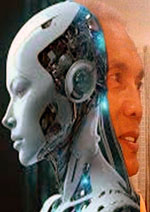
![]()
![]()
AI Conversation: Sentience
(December 10, 2024) I interact with AI almost daily, often asking questions to widen my knowledge base. But on this occasion, we had a meaningful conversation....more »»
»» back to Technology
»» back to Learning
»» back to Homepage
ARCHIVE 2025:
JAN |
FEB |
MAR
1970 |
1973 |
1975 |
1976 |
1977 |
1979 |
1981 |
1996 |
2000 |
2001 |
2002 |
2003 |
2004 |
2005 |
2006 |
2007 |
2008 |
2009 |
2010 |
2011 |
2012 |
2013 |
2014 |
2015 |
2016 |
2017 |
2018 |
2019 |
2020 |
2021 |
2022 |
2023 |
2024 |
2025 |
ALL BLOGS




